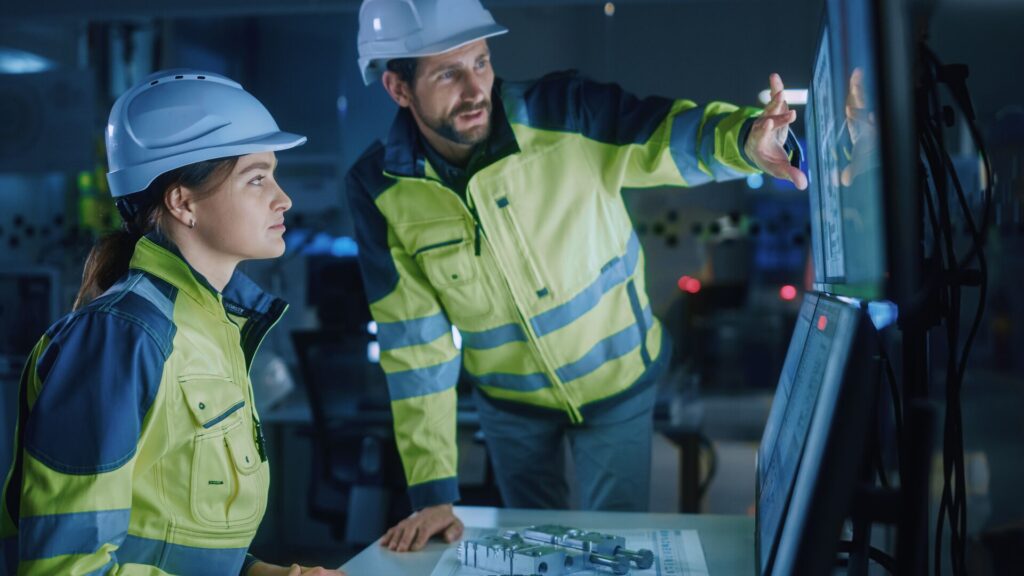
Understanding the “factory of the future”: How do we get there?
By Carolyne Van Der Meer
Features ABB factory of the future Smart building technology Stan Wachon Photo courtesy of ABB.
Photo courtesy of ABB. Smart building technology is getting more and more airplay these days, particularly in the manufacturing sector, where facilities large and small emit a significant percentage of greenhouse gases. In general, buildings are responsible for nearly 30% of all GHG emissions1—so imagine what a difference it could make if the manufacturing sector adopted technology that could significantly reduce energy consumption. The path to net zero emissions would certainly be smoother. But how do we get there? What are the things we need to think about?
CPECN had an opportunity to talk with ABB Canada’s business development manager for the food and beverage segment, Stan Wachon, about the “factory of the future.” With 30 previous years in industrial automation where he saw firsthand the issues that can arise in an industrial environment, and now several years with ABB, Stan has expert knowledge on what it takes to become an efficient, effective facility with streamlined operations that reduce waste and ultimately point the way to a greener, more sustainable future. In our discussion, Stan explained how a company can achieve the sought-after status of not just being forward-looking but actually making a difference in terms of energy efficient operations.
CPECN: Before we get into the how of it, can you tell us what is meant by the term “factory of the future”?
Stan Wachon (SW): For me, it’s an efficient, effective factory that can provide you with valid data on your operations, data that enables you to be predictive and preventative about your assets within the factory.
With data on your operations, you are now in control of your factory, versus the factory controlling you and causing you to be reactive. Data will enable you to understand exactly what your factory is doing, from the electrical side all the way down to the finished product. Setting it up can be costly, but the end result can be very functional and very, very beneficial to the environment.
CPECN: Before we talk about cost and steps and stages, can you tell us why gathering building data matters, what kind of data can be gathered—and how?
SW: Gathering data helps you understand what your factory is doing. And from there, you can find deficiencies that will ultimately enable you to create efficiencies. For example, in the food and beverage industry, I have customers that come to me knowing that they have inefficiencies, and know they need to upgrade, but because they can never stop production without incurring a loss, they can’t fully understand or address any of the issues that would make them more efficient. If they could gather data about their activity, that would start the conversation about what needs to happen next.
Let me give you an example to show you what kind of data can be gathered and how. Last year, I was approached by a company with a 100-year-old multi-level facility. As demand grew, they expanded the facility and added electrical systems with every expansion. Over time, some of the equipment became old and dated—and there is no metering being done to reveal and track the inefficiencies of these systems. To undertake any further expansion, they needed to gain a better understanding of their facility. We mounted non-intrusive panels beside their electrical equipment on various levels of the facility that allowed us to meter and monitor the energy being used. After three months of metering, they had a solid understanding of their power draw, what systems needed to be replaced and where they could further expand their facility.
Essentially, the first step is information—in other words, data. Once you have this, you can start to have a conversation about what comes next.
CPECN: Once you have an understanding of your environment, what is the next step in the process? And is the conversation as applicable to small facilities and projects as it is to large ones?
SW: With this conversation, we can start to build a plan to move things forward—and this can be as small as the replacement of breakers because they’re energy hogs. Or it could be a matter of changing lighting or upgrading motors that are too old. Making a reduction in one place can lead to adding a positive in another place.
CPECN: So let’s talk a little more about data collection. How does it work?
SW: There are cloud-based systems that will actually gather information from the electrical lines, telling you how much power you’re drawing in kilowatt hours. With the information we collect, based on electricity rates, we can determine the cost per day of the facility. So, it’s more than just basic data; it’s information about your power consumption and the energy you’re using. And in Ontario, where different rates are charged during the day, that understanding is key to someone who is running a 24/7 facility.
CPECN: And once you have the data, what happens next? Where do you start to make changes?
SW: The data actually dictates the next steps, such as whether you make a change from the front end or somewhere else in the process. Let’s say that someone is experiencing voltage sags from the electrical delivery provider. Dips in power delivery can disrupt electrical device operation. When the power comes back, there are two possible scenarios: you are operational, or the dip was so low that with an immediate power-up, the system gets damaged. In my experience, damage can be anywhere from $10,000 to $300,000 because of a fluctuation in the power. If we know that within three months, there have been 10 fluctuations that led to the replacement of equipment, that means you will want to start from the front end. You don’t want unplanned outages to result in equipment replacement. When that happens, you end up dealing with a panoply of other issues: the motors you need are not in stock, your production is stalled, and unfinished product was wasted.
CPECN: Starting from the front end means being preventive; in other words replacing the outdated equipment, as opposed to repairing it when it breaks, or only making a change when a power disruption forces you to.
SW: Exactly. The newer technology won’t draw as much power, so you’re now removing the additional energy being used at the front end. Once you have dealt with this, you can begin to tackle other issues that might be deeper in the factory. The plan you initiate could be in small steps, first by reducing the amount of energy used and then by tackling the more expensive issues, like a power conditioning system, which would be a capital expenditure.
CPECN: How does gathering data and the plan that comes from that lead to increased sustainability and a reduced footprint?
SW: The plan will allow you to use more energy-efficient equipment and you can consider bringing in automation that will increase that efficiency. You can add renewables such as solar panels so you can actually drive the building to be even more energy efficient. I’ll give you a recent example from a discussion I had with a large general contractor that believes green energy buildings are the way of the future. We discussed how we could incorporate the circulation of air through the floor so that the building would not require a lot of heat. This is something you could plan for—a little bit more costly up front, but the return is much quicker once you are operational because you’re not using that energy. This is an example of an opportunity to be more predictive and preventative in your system instead of reactive. In the factory of the future, every little piece actually has an effect on another piece.
We also have to ask ourselves what the goal is when we say we want to be sustainable: I want to be sustainable in the way I create my product: create no waste, have no recalls. I want to make things on my own without worrying about anything else. I want carbon neutrality, net zero. You can only get to this dialogue once you can corral the issues within your plant. And some of these are smaller issues that can be dealt with during downtimes or during sanitization, for example.
CPECN: Can you talk about the timeframe around becoming more energy efficient because you are able to gather data and understand your environment?
SW: With a facility that is looking to improve energy efficiencies but doesn’t need to consider large changes or capital expenditures, data can be gathered, and a plan developed and executed within three to six months. If it’s a large build, potentially a year. At ABB, we offer analytics and engineering studies to help the customer figure out the direction. We come in and actually set up equipment to do the data collection for them for a certain period of time, and analyze it, generate a report and work with them to build a plan. For this, you need three to six months. Many companies nowadays don’t have engineering departments or large maintenance departments. They rely on external suppliers, so when there’s an issue on site, an external electrical contractor comes in and, on demand, and fixes the issue. That’s more reactive than proactive, right? If a facility can just get data, they can actually be more proactive about what they’re doing in the face of issues they know will arise.
Immediate change causes a lot of disruption and might be more costly, but gradual change can be sustainable and can give us a little bit more satisfaction: of saying I’m doing something to make it better. This is what will get us even closer to the ultra-efficient factory of the future.

Stan Wachon is senior business development manager for ABB servicing the Food & Beverage and Packaging Industries across Canada. Photo courtesy of ABB.
Stan Wachon is senior business development manager for ABB servicing the Food & Beverage and Packaging Industries across Canada. He has many years of experience creating and providing solutions in complete electrical, control, SQL, visualization, safety and robotics environments. In addition to his experience at ABB, he has 30 years of experience in industrial automation.
1Canada Green Building Council. “LEED: The global standard in green building.” Accessed February 27, 2024.
Carolyne Van Der Meer is a public relations and communications professional, journalist and author. Learn more about her at cvdmcommunications.com.
Print this page